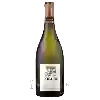
Winery Peyre RoseMarlène No. 3
In the mouth this red wine is a powerful with a nice balance between acidity and tannins.
This wine generally goes well with beef, veal or pasta.
The Marlène No. 3 of the Winery Peyre Rose is in the top 5 of wines of Languedoc.
Taste structure of the Marlène No. 3 from the Winery Peyre Rose
Light | Bold | |
Smooth | Tannic | |
Dry | Sweet | |
Soft | Acidic |
In the mouth the Marlène No. 3 of Winery Peyre Rose in the region of Languedoc-Roussillon is a powerful with a nice balance between acidity and tannins.
Wine flavors and olphactive analysis
On the nose the Marlène No. 3 of Winery Peyre Rose in the region of Languedoc-Roussillon often reveals types of flavors of blackberry, leather or pepper and sometimes also flavors of black fruits, truffle or cassis.
Food and wine pairings with Marlène No. 3
Pairings that work perfectly with Marlène No. 3
Original food and wine pairings with Marlène No. 3
The Marlène No. 3 of Winery Peyre Rose matches generally quite well with dishes of beef, pasta or veal such as recipes of oxtail and carrot stew, elodie's pasta risotto or duck breast with red fruits.
Details and technical informations about Winery Peyre Rose's Marlène No. 3.
Discover the grape variety: Rayon d'or
Rayon d'or blanc is a grape variety that originated in . This grape variety is the result of a cross between the same species (interspecific hybridization). It produces a variety of grape specially used for wine making. It is rare to find this grape to eat on our tables. We can find the Rayon d'or blanc cultivated in these vineyards: Rhône Valley, Loire Valley, Savoie & Bugey, Beaujolais, Languedoc & Roussillon.
Last vintages of this wine
The best vintages of Marlène No. 3 from Winery Peyre Rose are 2002, 2004, 2005, 2007 and 2006.
Informations about the Winery Peyre Rose
The Winery Peyre Rose is one of of the world's greatest estates. It offers 5 wines for sale in the of Languedoc to come and discover on site or to buy online.
The wine region of Languedoc
Languedoc (formerly Coteaux du Languedoc) is a key appellation used in the Languedoc-Roussillon wine region of southern France. It covers Dry table wines of all three colors (red, white and rosé) from the entire region, but leaves Sweet and Sparkling wines to other more specialized appellations. About 75% of all Languedoc wines are red, with the remaining 25% split roughly down the middle between whites and rosés. The appellation covers most of the Languedoc region and almost a third of all the vineyards in France.
The wine region of Languedoc-Roussillon
Languedoc (formerly Coteaux du Languedoc) is a key appellation used in the Languedoc-Roussillon wine region of southern France. It covers Dry table wines of all three colors (red, white and rosé) from the entire region, but leaves Sweet and Sparkling wines to other more specialized appellations. About 75% of all Languedoc wines are red, with the remaining 25% split roughly down the middle between whites and rosés. The appellation covers most of the Languedoc region and almost a third of all the vineyards in France.
The word of the wine: Sapid
Said of a wine rich in flavours.













